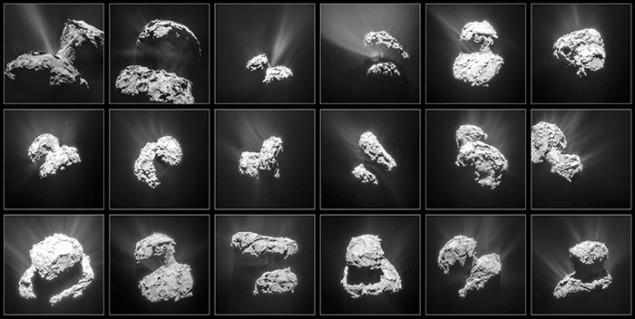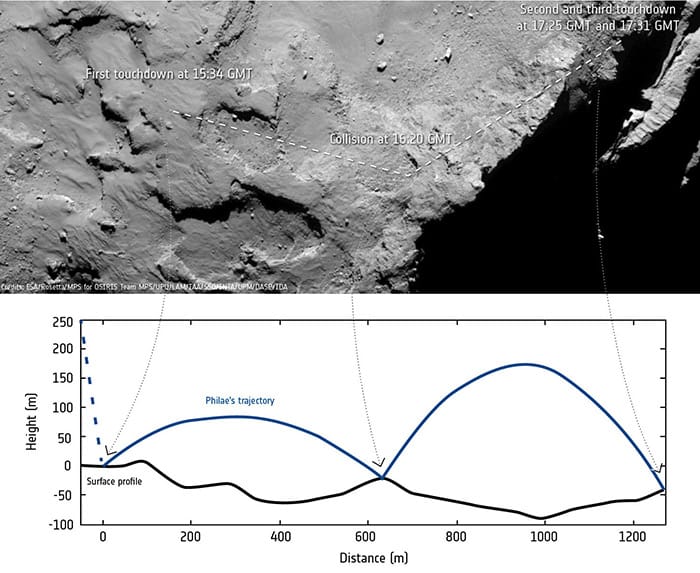
The comet 67P/Churyumov–Gerasimenko has no global magnetic field, according to scientists working on the European Space Agency’s Rosetta mission. The magnetic measurements were made in November last year by the mission’s Philae lander, which bounced twice from the comet’s surface before settling down. This is the first reliable measurement of the magnetic field of a comet, and the null value provides important information about the magnetic fields present in the early solar system. The result also casts doubt on the idea that magnetic forces played an important role in the formation of comets.
Comets are a mixture of dust, rock and frozen gases that probably formed in the outer reaches of the very early solar system. Comets have not changed much since then, so they could provide important insights into the material from which the Sun and the planets formed. Exactly how comets are created is not clear, and one possibility is that magnetic forces between grains of iron-based dust helped pull together dust and gases to create progressively larger objects that eventually become comets.
If these magnetic-dust grains accumulated in the presence of an external magnetic field, their magnetic moments would align and give the comet an overall magnetization. Therefore if comets such as 67P/Churyumov–Gerasimenko have global magnetic fields, this would tell scientists something about the magnetic fields that existed in the early solar system.
Solar wind
Detecting a comet’s weak magnetic field, however, is extremely difficult because the field strength drops off rapidly the further away the probe is from the surface of the comet. In addition, magnetic effects created by the solar wind must be taken into account when making extremely precise magnetic measurements.
In the 1980s, the GIOTTO spacecraft found no discernible magnetic field around Halley’s comet. However, this was a “fly-by” measurement made at a distance of about 600 km, and is not considered conclusive. Other magnetic measurements of comets have also proven inconclusive, while similar measurements on asteroids have found some to be magnetic and others not to be.
The Rosetta mission arrived at 67P/Churyumov–Gerasimenko last year, and deployed the Philae lander to the comet’s surface. Scientists have now used data from two of its instruments to measure the magnetic properties of the comet. The first is the Rosetta Lander Magnetometer and Plasma Monitor (ROMAP) on the Philae lander. ROMAP is deployed on the end of a 60 cm retractable rod, and detects the local magnetic field as well as the ambient level of charged particles. The second instrument is the Rosetta Plasma Consortium Fluxgate Magnetometer (RPC-MAG). This is based on the main Rosetta spacecraft, and monitored the solar wind as ROMAP travelled to the comet’s surface on Philae, bounced twice and then settled down on the surface.
Bouncing along
While the bouncing was not planned, it did provide scientists with magnetic measurements at three different points along a 1.2 km stretch of the comet’s surface. Measurements were also taken as the lander flew over the comet between bounces, reaching a height of about 150 m. After correcting for the effects of the solar wind as determined by RPC-MAG, the team found very little variation in the magnetic field measured by ROMAP, which was less than about 2 nT. In comparison, Earth’s magnetic field is about 25–65 μT at the surface.
If the nucleus of the comet is assumed to be a magnetic dipole, then the team calculates it would have a dipole strength of less than 1.6 × 108 Am2. On the other hand, if the magnetic field is the result of randomly oriented pieces of magnetic rock within the comet, the specific magnetic moments of those rocks would have to be less than about 3.1 × 10–5 Am2/kg. This is much smaller than the specific moment of material found on the surface of the Moon or in meteorites on Earth.
Low magnetic fields
Putting all of this together, the team has concluded that the comet is not magnetic. An important consequence of this is that 67P/Churyumov–Gerasimenko must have formed in a region of low magnetic fields. “We now know that magnetic fields were not strong in the early solar system,” explains Karl-Heinz Glassmeier of the Technical University of Braunschweig in Germany.
Furthermore, if 67P/Churyumov–Gerasimenko is typical of other comets, then magnetic forces are unlikely to have played a role in pulling together objects that are greater than about 1 m across during the formation of comets and possibly planets. However, team member Hans-Ulrich Auster – also at Braunschweig – points out that the Rosetta measurements do not rule out the possibility that magnetic forces were involved in pulling together particles that were several centimetres or less in size.
The research is described in Science.




